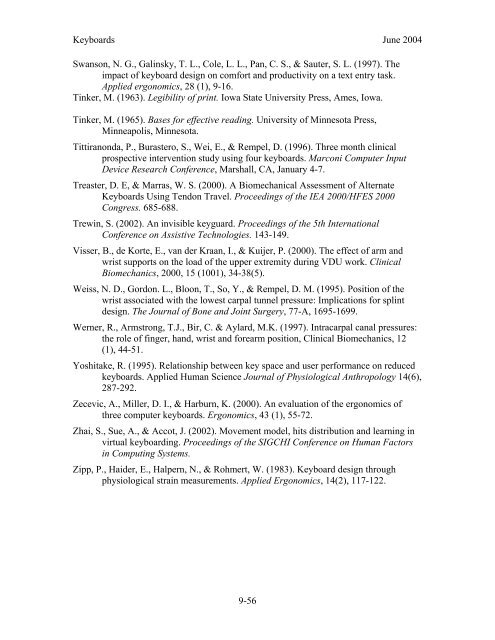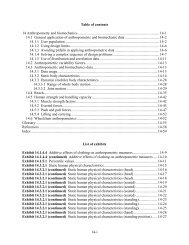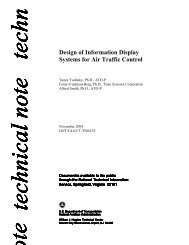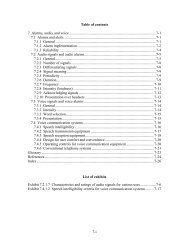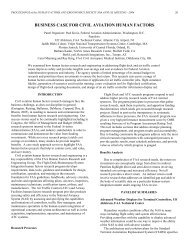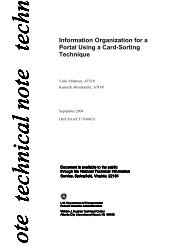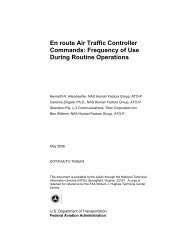Keyboards June 2004Siebel, R. (1962). Per<strong>for</strong>mance on a five-finger chord keyboard. Journal <strong>of</strong> AppliedPsychology, 46 (3), 165-169.Sihvonen, T., Baskin, K, & Hanninen, O. (1989). Neck-shoulder loading inwordprocessor use: effect <strong>of</strong> learning, gymnastics, & arm supports. InternationalArch. Occupational <strong>and</strong> environmental health, 61, 229-233.Simoneau, G. G., & Marklin, R. W. (2001). Effects <strong>of</strong> computer keyboard slope <strong>and</strong>height on wrist extension angle. <strong>Human</strong> <strong>Factors</strong>, 43 (2), 287-298.Simoneau, G. G., Marklin, R. W., & Berman, J. E. (2003). Effects <strong>of</strong> computer keyboardslope on wrist position <strong>and</strong> <strong>for</strong>earm electromyography <strong>of</strong> typists withoutmusculoskeletal disorders. Physical <strong>the</strong>rapy. 83(9), 816-830.Simoneau, G. G., Marklin, R. W., & Monroe, J.F. (1999). Wrist <strong>and</strong> <strong>for</strong>earm postures <strong>of</strong>users <strong>of</strong> convenetional computer keyboards. <strong>Human</strong> <strong>Factors</strong>, Sept. 41(3), 413.Simoneau, G. G., Marklin, R. W., Monroe, J., & Zabors, J. (1996). Wrist <strong>and</strong> <strong>for</strong>earmposition during a typing task using various keyboard models. American Society <strong>of</strong>Biomechanics, 20th Annual Meeting. Atlanta, GA.Smith, M. J., Karsh, B, Conway, F., Cohen, W., James, C., Morgan, J., S<strong>and</strong>ers, K, &Zehel, D. (1998). Effects <strong>of</strong> a split keyboard design <strong>and</strong> wrist rest onper<strong>for</strong>mance, posture, <strong>and</strong> com<strong>for</strong>t, <strong>Human</strong> <strong>Factors</strong>, 40 (2), 324-336.Smith, S. L., & Mosier, J. N. (1986). Guidelines <strong>for</strong> designing user interfaces<strong>of</strong>tware(ESD-TR-86-278). Hanscom AFB, MA: Electronic Systems Division.Sommerich, C. M. (1994). Carpal tunnel pressure during typing: Effects <strong>of</strong> wrist posture<strong>and</strong> typing speed. Proceedings <strong>of</strong> <strong>the</strong> <strong>Human</strong> <strong>Factors</strong> <strong>and</strong> Ergonomics Society38th Annual Meeting. Santa Monica, CA: <strong>Human</strong> <strong>Factors</strong> <strong>and</strong> ErgonomicsSociety, 611Sommerich, C.M. (2000). Inputting to a Notebook Computer. Proceedings <strong>of</strong> <strong>the</strong>IEA2000/HFES 2000 Congress. 671-674.Stevens, S. S. (1975). Psychophysics-Introduction to its perceptual, neural <strong>and</strong> socialprospects. In Ergonomic <strong>Design</strong> <strong>for</strong> people at work. Vol.1 (1983). S.H. Rodgers &E.M. Eggleton (Eds.), Eastman Kodak Company. New York: Van Nostr<strong>and</strong>Reinhold.Straker L., Jones K. J., Miller J. A. (1997). Comparison <strong>of</strong> <strong>the</strong> postures assumed whenusing laptop computers <strong>and</strong> desktop computers. Applied Ergonomics, 28 (4), 263-268.Strasser, H., Keller, E. & Fleischer, R. (2000). Electromyographic evaluation <strong>of</strong> musclestrain <strong>of</strong> <strong>the</strong> h<strong>and</strong>-arm-shoulder system during alternating typing at a conventional<strong>and</strong> ergonomic keyboard. Proceedings <strong>of</strong> <strong>the</strong> <strong>Human</strong> <strong>Factors</strong> <strong>and</strong> ErgonomicsSociety. 360-363.Su<strong>the</strong>r, T., & McTyre, J. (1982). Effect on operator per<strong>for</strong>mance at thin pr<strong>of</strong>ile keyboardslopes <strong>of</strong> five, ten, fifteen, <strong>and</strong> twenty-five degrees. Proceedings <strong>of</strong> <strong>the</strong> <strong>Human</strong><strong>Factors</strong> <strong>and</strong> Ergonomics Society. 26, 430.9-55
Keyboards June 2004Swanson, N. G., Galinsky, T. L., Cole, L. L., Pan, C. S., & Sauter, S. L. (1997). Theimpact <strong>of</strong> keyboard design on com<strong>for</strong>t <strong>and</strong> productivity on a text entry task.Applied ergonomics, 28 (1), 9-16.Tinker, M. (1963). Legibility <strong>of</strong> print. Iowa State University Press, Ames, Iowa.Tinker, M. (1965). Bases <strong>for</strong> effective reading. University <strong>of</strong> Minnesota Press,Minneapolis, Minnesota.Tittiranonda, P., Burastero, S., Wei, E., & Rempel, D. (1996). Three month clinicalprospective intervention study using four keyboards. Marconi Computer InputDevice Research Conference, Marshall, CA, January 4-7.Treaster, D. E, & Marras, W. S. (2000). A Biomechanical Assessment <strong>of</strong> AlternateKeyboards Using Tendon Travel. Proceedings <strong>of</strong> <strong>the</strong> IEA 2000/HFES 2000Congress. 685-688.Trewin, S. (2002). An invisible keyguard. Proceedings <strong>of</strong> <strong>the</strong> 5th InternationalConference on Assistive Technologies. 143-149.Visser, B., de Korte, E., van der Kraan, I., & Kuijer, P. (2000). The effect <strong>of</strong> arm <strong>and</strong>wrist supports on <strong>the</strong> load <strong>of</strong> <strong>the</strong> upper extremity during VDU work. ClinicalBiomechanics, 2000, 15 (1001), 34-38(5).Weiss, N. D., Gordon. L., Bloon, T., So, Y., & Rempel, D. M. (1995). Position <strong>of</strong> <strong>the</strong>wrist associated with <strong>the</strong> lowest carpal tunnel pressure: Implications <strong>for</strong> splintdesign. The Journal <strong>of</strong> Bone <strong>and</strong> Joint Surgery, 77-A, 1695-1699.Werner, R., Armstrong, T.J., Bir, C. & Aylard, M.K. (1997). Intracarpal canal pressures:<strong>the</strong> role <strong>of</strong> finger, h<strong>and</strong>, wrist <strong>and</strong> <strong>for</strong>earm position, Clinical Biomechanics, 12(1), 44-51.Yoshitake, R. (1995). Relationship between key space <strong>and</strong> user per<strong>for</strong>mance on reducedkeyboards. Applied <strong>Human</strong> Science Journal <strong>of</strong> Physiological Anthropology 14(6),287-292.Zecevic, A., Miller, D. I., & Harburn, K. (2000). An evaluation <strong>of</strong> <strong>the</strong> ergonomics <strong>of</strong>three computer keyboards. Ergonomics, 43 (1), 55-72.Zhai, S., Sue, A., & Accot, J. (2002). Movement model, hits distribution <strong>and</strong> learning invirtual keyboarding. Proceedings <strong>of</strong> <strong>the</strong> SIGCHI Conference on <strong>Human</strong> <strong>Factors</strong>in Computing Systems.Zipp, P., Haider, E., Halpern, N., & Rohmert, W. (1983). Keyboard design throughphysiological strain measurements. Applied Ergonomics, 14(2), 117-122.9-56


